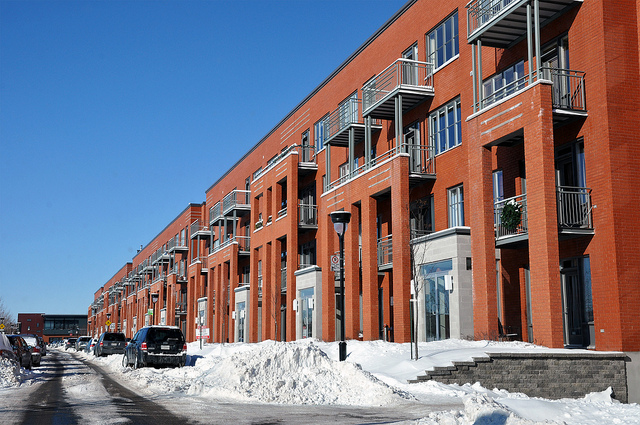Please support our coverage of democratic movements and become a supporting member of rabble.ca.
In Quebec, the coming of the new millennium coincided with a crisis in rental housing. From 2000 to 2003, each Canada Day, families ended up homeless, unable to find housing. The crisis situation eventually gave way to times of shortage (2004-2012). They seem to be coming to a close this year. From 1999 to 2012, the vacancy rate in the rental market never went over the 3 per cent threshold, the point of equilibrium. This spring, for the first time in 15 years, it has gone over with a 3.1 per cent vacancy rate in Quebec’s urban centres.
The current return to balance has been delayed a few years notably because public authorities stubbornly banked on developing home ownership policies instead of building social housing. Many perverse byproducts have also been noted: gentrification, urban sprawl, condo over-production… In addition, the upward trend in rent prices observed since 2000 has not lost momentum, for the moment at least, despite the rental market’s return to balance.
Furthermore, balance has not been restored in all cities in Quebec.
Indeed, the crisis carries on acutely in cities outside of the major centres. Prime examples are Rouyn-Noranda (in northwestern Quebec, near the border with Ontario) and Sept-Îles (in northeastern Quebec, nearby Labrador): the vacancy rate there does not even reach 1 per cent! On top of this anemic vacancy rate, both regional centres have another point in common: these cities are going through a bit of an economic boom thanks to natural resources. You could call them boomtowns: they are taking in an influx of workers coming to find a job while resource prices favour their extraction.
Similar migrations take place across the globe. The discovery and production of shale gas in Pennsylvania led to unprecedented consequences in the housing market. In the last few years, rental prices tripled in some counties. It’s simple supply and demand. The number of available housing units is below the demand and the income of those looking for a place to stay is exploding.
Same phenomenon in North Dakota, going through an oil boom. Even with an average income of $98,000, some workers are sleeping in their cars or in rudimentary work camps. In addition, those who have lived in the region for years are incapable of paying the prices asked for in the private rental market. The very limited supply of social housing obviously does not help. Similarly, new inhabitants working outside the oil industry do not have the means to follow the market price, boosted by the new high salaries. For example, to house teachers, schools are setting up trailers on their grounds because they have no other way to guarantee relatively decent housing for their limited-income workforce.
Mining booms create a number of city management problems beyond housing issues. They increase road traffic and lead to an influx of (mostly male) population. Electricity and water supply systems as well as waste collection become inadequate. There are not enough local services and businesses in the short and medium term. To attract and retain a population, boomtowns must develop basic services (hospitals, schools, etc.), but also diversify retail and entertainment offerings.
Of course, some real estate developers know a good thing when they see it and go on to build new properties in boomtowns both in Quebec and in the U.S. However, rather than ensuring that they diversify the market and make it affordable for the entire population, they target the new (and wealthier) inhabitants. Yet these people are generally more mobile because they will only stay as long as the industry needs their workforce. Indeed, they sometimes won’t even bother buying a house and will just live in work camps instead!
In the specific case of oil and shale gas, installing the wells is what requires the most human resources. Beyond this stage, the bustle in villages which have become cities decreases, leaving empty properties once too expensive for those who were unable to house themselves. It makes it hard for municipalities to sustainably develop their infrastructures and services.
Housing is one of the major challenges posed by the mining boom promised in the Plan Nord, beyond the environmental issues it raises and the economic project’s extractivist logic. (Though we are still waiting for it to be rolled out in specific, practical ways…) Banking on production and exportation too often limits regional development at the expense of the local population, which hopes to revitalize its locality not only economically, but also culturally. Indeed, a city or a region is more than just people and jobs: it’s a community and a culture. Housing is central to creating a sense of belonging.
This article was written by Eve-Lyne Couturier and Philippe Hurteau, researchers with IRIS, a Montreal-based progressive think tank.
Photo: caribb/Flickr




